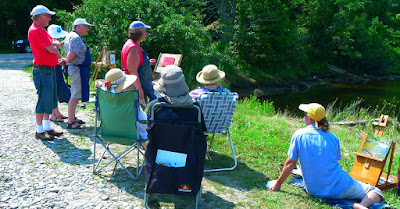As ever, these are arm’s length recommendations; I don’t receive a spiff.
 |
| Mary Whitney with a Strada micro easel. |
Easels: beginners often buy French easels, but please don’t do that. They’re heavy and tough to set up. Instead, choose a smaller, lighter, more efficient easel—the Mabef field painting easel M27. The pivot head makes it useful for both oils and watercolor. It comes with extension arms on which you can set a palette. I’ve had an earlier version of this for two decades. It’s my number one choice for watercolor, and I’m constantly loaning it to new painters.
More advanced painters would love a good pochade box. There are many fine ones on the market, including Open Box M, EASyL, and Strada. If your painter has a nice pochade box but complains about the weight of his kit, consider getting him a carbon-fiber tripod. They’ll need a pivot head and quick-release plate.
 |
| A Beauport easel can handle a big canvas. This is 40X40. |
Occasionally, one needs a larger easel for the field. The Beauport is a variation of the traditional Gloucester easel. One of my tasks this morning will be to order a replacement, because I finally snapped mine in the wind at Cape Elizabeth this season. But don’t let that mislead you; it’s had decades of hard use.
Stanrite #500 studio easel is the teaching easel I use in my studio. Aluminum is light, easy to move, and easy to stow. Want a larger version? Try its big brother, the Stanrite #700. These easels get daily use and never need maintenance.
 |
| Dorothy Shearn demonstrates the proper use of a sketchbook. The grapefruit tree was a completely gratuitious extra. |
Brushes:
Alla prima oil painters use hog bristle brushes; indirect painters use softer brushes. Over the years, Princeton has provided great value for money. In watercolor, their Neptuneline remains my go-to demo brush, even though I have a lot of pricier brushes in my kit. They’ve rebranded their old-reliables as SNAP but the quality remains. Series 9700 is a natural bristle brush made for oil-painting. Series 9800 is a synthetic for oils. Series 9650 is made for watercolor and acrylic.
If you really want to surprise someone with your inside knowledge and impeccable taste, choose Rosemary & Co. brushes for watercolor or oil, or New York Central for oil painting brushes.
 |
| Nancy Holland and Gwen Mottice demonstrating proper kit for oil painters at Goodwood Plantation in Tallahassee. |
Pigments and paints: QoR watercolor kit: QoR (allegedly pronounced “core”) is a product of Golden Artist Colors, so they’re high-quality paints. I use QoR myself, and for my workshops aboard schooner American Eagle. You can easily buy ready-made sets of 6-12 pigments from any large paint dealer online. For acrylics, I recommend a Golden starter set . For oils, buy Robert Gamblin, Gamblin 1980 (student grade), Winsor & Newton, or Winton (student grade). It’s harder to make a one-size-fits-all recommendation for pastels, but anything sold by Dakota Art Pastels is a good product.
If your artist has all the paints he thinks he needs, why not surprise him with some gouache? Turner, M. Graham, Winsor & Newton and Holbeinare all good brands.
In every case, less is more. The artist typically needs no more than a dozen colors, and it’s better to get a better brand with fewer pigments than a large assortment of cheap paint.
Sketchbooks: I buy Strathmore 300 series Visual Journals and consume them like candy. They’re available for cheap at my local odd lots store, so don’t overpay at an office supply store. For fast outdoor sketching, I like the Strathmore 400 watercolor series. They’re so affordable, I have no worries about wasting paper.
Miscellany: A Quiller wheel is an indispensable tool for any beginner painter. It tells you where real-world pigments fall on the traditional color wheel. Every oil painter needs a stainless steel airtight brush washer. If your painter is interested in plein air, make sure it’s small and can hang. Brush soapis always useful.
The Aqua Toteis a collapsible water tank/brush holder for water media. Or surprise your painter with a Cotman Compact watercolor set; it can slide into a purse and travel anywhere. [AUTHOR’S NOTE: See Bruce McMillen’s comment, below; I agree with his comment about Cotman. What was I thinking?]



















